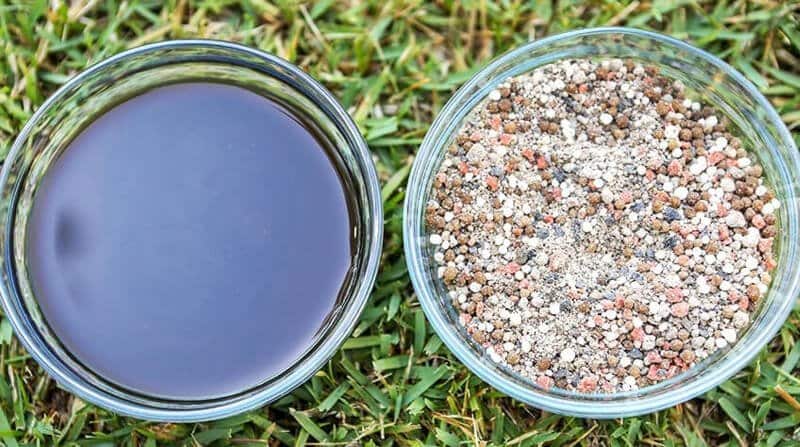When it comes to fertilising your lawn, things can often get confusing.
One of the causes of confusion is the type of lawn fertiliser you should use. Should you use liquid lawn food or granular fertiliser?
The short answer is, ‘use both’.
However, that on its own doesn’t help much so this in this article I’ll explain when to feed your lawn with one over the other as well as how to use them in conjunction with each other.
The Differences Between Granular and Liquid Lawn Food
Before you can fully understand which type of fertiliser you should use and when, it helps to understand the differences between them.
Granular Lawn Feed
Granular fertilisers release their nutrients over a period of time as the granules break down into the soil.
Most release their nutrients over a period of 10-12 weeks although some work over shorter periods, some longer.
You can apply granular feed by hand which is OK for small lawns. However, it becomes much less accurate over larger lawns. In which case it’s best to use a lawn spreader.
Moisture in the soil activates the fertiliser and the nutrients get consumed by the grass via its roots, stimulating growth and greening of the leaf.
Liquid Lawn Food
Liquid lawn feeds are typically much faster-acting and generally work over 2-4 weeks.
They’re generally mixed with water and applied via watering can or knapsack sprayer.
The nutrients enter the grass plants via the leaf instead of the roots which causes growth and greening of the lawn much quicker than granular feeds.
How to Use Granular and Liquid Fertilisers
The mistake many gardeners make is using one type of fertiliser over another. However, in order to achieve perfection, lawn care professionals use both.
Granular products are used for ‘base feeding’ while liquid feeds are used for ‘demand feeding’.
Base Feeding With Granular Lawn Fertiliser
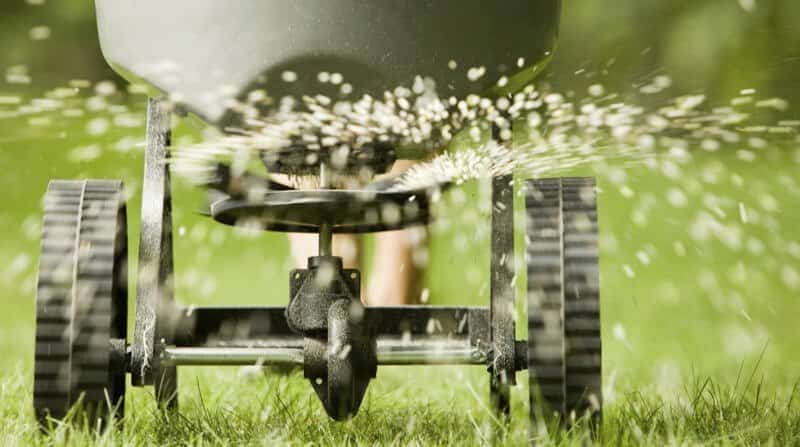
Granular fertilisers are used for what professionals called base feeding.
For domestic lawns, they’re generally applied 4 times a year. Once in spring, summer autumn and winter.
They should be applied routinely and feed your lawn over a period of weeks.
You could liken base feeding to us humans having breakfast, lunch and dinner.
Demand Feeding With Liquid Fertiliser
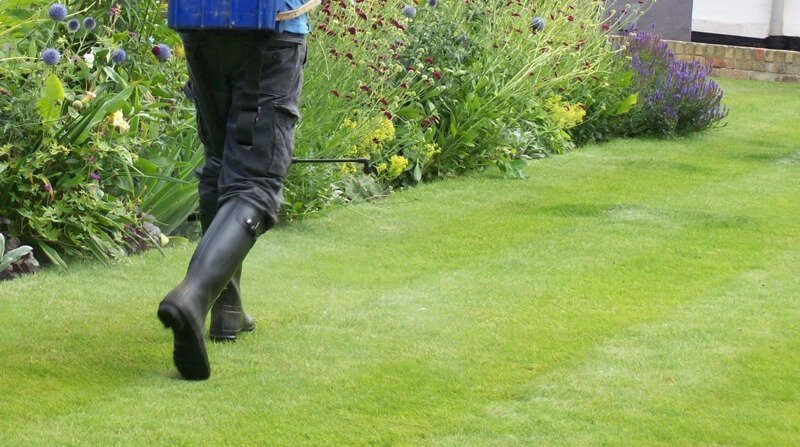
Demand feeding is used when your lawn needs a little ‘pick me up’ as and when it’s needed to stimulate growth and greening of the leaf.
The Nitrogen content is usually quite high in liquid feed so you need to be careful as to how much you apply.
Demand feeding is like us having a snack between meals.
Other Types of Lawn Food and How to Use Them
It’s not just dedicated fertilisers which come in liquid or granular based products.
Lawn Weed and Feed
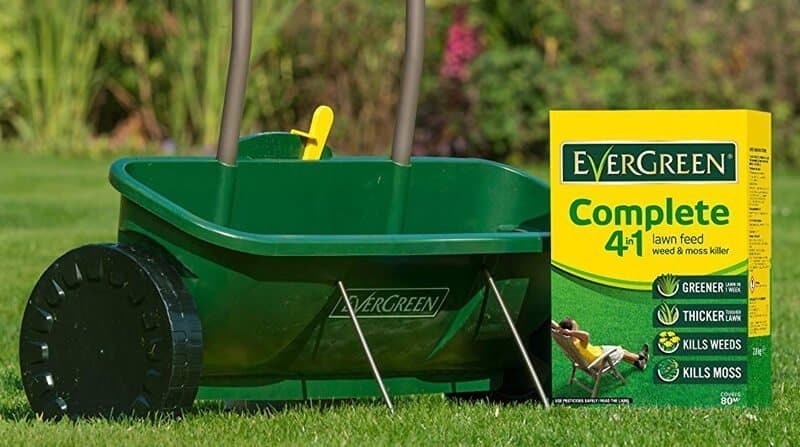
Lawn weed and feed products are marketed as ‘all in one’ kind of products. Their big sell is that they save you both time and money.
They come as both granular products, like Evergreen 4-in-1 Complete, or in liquid form like Vitax Green Up.
You’d generally apply them once or twice a year, depending on the product.
They claim to save time because they kill moss and broad-leafed weeds while feeding the lawn at the same time. They also claim to save money because instead of buying a separate moss killer, a dedicated weed killer and fertiliser, you essentially have it all in one product.
Iron Sulphate
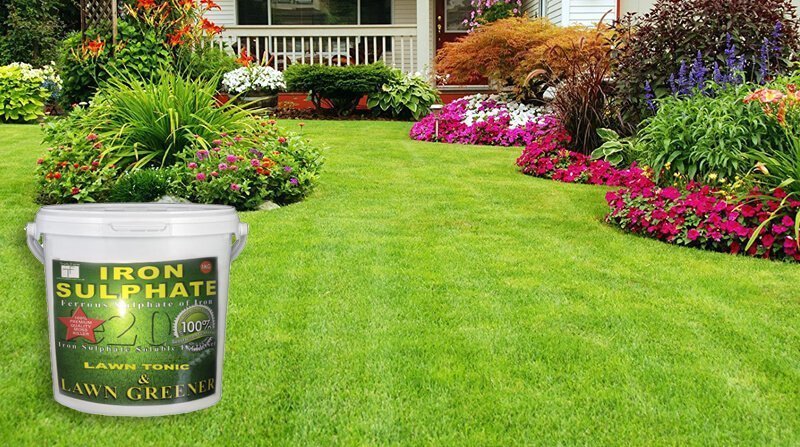
Most lawn fertilisers contain Nitrogen (N), Potassium (P) and Phosphate (K). But there are other elements that your grass needs in trace amounts. These include;
- Molybdenum
- Boron
- Copper
- Chlorine
- Zinc
- Magnesium
- Iron
Most soils contain these elements and only the poorest soils lack them. That said, all of the elements listed, Iron is the one that typically lacks the most.
Iron Sulphate (or Ferrous Sulphate) not only kills moss, but it’s also a component of Chlorophyll which is what makes your grass green.
Applying a dose or two during the winter keeps moss in check, gives your grass a boost of green colour and also hardens the grass against the cold and wet.
It comes in a powder form which you mix with water and apply as a liquid.
However, you should use Ferrous Sulphate with caution as it can permanently stain. Some fertiliser manufacturers add it to their weed and feed products to give the grass an extra boost of green so be very careful when using them not to stain pathways, driveways or patios.
Which Type of Lawn Food Should You Use? Clearing Up the Confusion
Like many things when it comes to caring for your lawn, the answer is, ‘It depends’.
That said, this is how I’d look at it.
If You Don’t Like Gardening
If there are a million other things you’d prefer to do than spend time gardening, then use a weed and feed.
Evergreen 4-in-1 Complete can be applied twice a year. Once in the spring and once in the autumn.
Vitax Green Up is a ‘once a year’ feed.
Understand though, that these products are designed to keep on top of weeds and moss. If you’ve got more moss and weeds than grass, they won’t help you.
In order to fix these issues, you’ll need to rake away the moss, scarify to remove excess lawn thatch and aerate your lawn to improve penetration of water, oxygen and nutrients into the soil.
You’ll also have to accept that putting in the bare minimum of work will mean a less than perfect lawn.
If You’re An Enthusiast
If you enjoy spending time in the garden and you’re willing to put the effort into creating and maintaining a really nice lawn, then apply a granular base feed every season.
A product like Scotts Spring/Summer Lawn Builder can be applied in April and July. Their Autumn/Winter Lawn Builder can be applied in September and January.
If You’re After Perfection
Apply a base feed to your lawn once a season as explained above.
If at any point your lawn looks a bit tired during the spring or summer, apply a dose of liquid feed to give it a boost.
During the winter give your lawn a dose of Iron Sulphate in December/February to give it boost of colour and harden the turf against the cold.
In Conclusion
As I said right at the beginning of this article, knowing which type of lawn feed to use and when can be confusing.
I hope this article has cleared things up for you.
Remember, use granular fertilisers as the base feed and liquid lawn feed as a top-up when your lawn needs it.
If you only choose one way to feed your lawn, choose granular.
